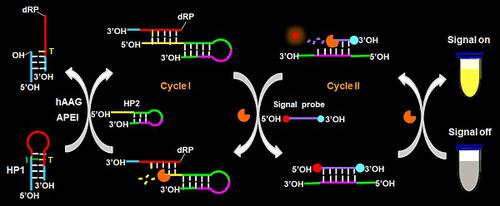当前位置:
X-MOL 学术
›
Theranostics
›
论文详情
Our official English website, www.x-mol.net, welcomes your
feedback! (Note: you will need to create a separate account there.)
Controllable Autocatalytic Cleavage-Mediated Fluorescence Recovery for Homogeneous Sensing of Alkyladenine DNA Glycosylase from Human Cancer Cells.
Theranostics ( IF 12.4 ) Pub Date : 2019-01-01 , DOI: 10.7150/thno.35393 Li-Juan Wang 1 , Ming-Li Luo 1 , Xiao-Yun Yang 2 , Xiao-Fang Li 2 , Yanxia Wu 2 , Chun-Yang Zhang 1
Theranostics ( IF 12.4 ) Pub Date : 2019-01-01 , DOI: 10.7150/thno.35393 Li-Juan Wang 1 , Ming-Li Luo 1 , Xiao-Yun Yang 2 , Xiao-Fang Li 2 , Yanxia Wu 2 , Chun-Yang Zhang 1
Affiliation

|
DNA alkylation and oxidation are two most common forms of cytotoxic damage with the characteristics of mutagenic and carcinogenic. Human alkyladenine DNA glycosylase (hAAG) is the only glycosylase known to repair a wide variety of alkylative and oxidative DNA lesions. However, few approaches are capable of real-time monitoring hAAG activity. Methods: Herein, we develop a facile fluorescent strategy for homogeneous and sensitive sensing of hAAG activity based on the controllable autocatalytic cleavage-mediated fluorescence recovery. The presence of hAAG enables the cleavage of hairpin probe 1 (HP1) at the damaged 2'-deoxyinosine site by AP endonuclease 1 (APE1), forming a DNA duplex. The trigger 1 built in the resultant DNA duplex may hybridize with hairpin probe 2 (HP2) to induce the T7 exonuclease (T7 exo)-catalyzed recycling cleavage of HP2 (Cycle I) to release trigger 2. The trigger 2 can further hybridize with the signal probe (a fluorophore (FAM) and a quencher (BHQ1) modified at its 5' and 3' ends) to induce the subsequent recycling cleavage of signal probes (Cycle II) to liberate FAM molecules. Through two-recycling autocatalytic cleavage processes, large amounts of fluorophore molecules (i.e., FAM) are liberated from the FAM-BHQ1 fluorescence resonance energy transfer (FRET) pair, leading to the amplified fluorescence recovery. Results: Taking advantage of the high accuracy of in vivo DNA repair mechanism, the high specificity of T7 exo-catalyzed mononucleotides hydrolysis, and the high efficiency of autocatalytic recycling amplification, this strategy exhibits high sensitivity with a detection limit of 4.9 × 10-6 U/μL and a large dynamic range of 4 orders of magnitude from 1 × 10-5 to 0.1 U/μL, and it can further accurately evaluate the enzyme kinetic parameters, screen the potential inhibitors, and even quantify the hAAG activity from 1 cancer cell. Conclusion: The proposed strategy can provide a facile and universal platform for the monitoring of DNA damage-related repair enzymes, holding great potential for DNA repair-related biochemical research, clinical diagnosis, drug discovery, and cancer therapy.
中文翻译:

可控的自催化裂解介导的荧光回收,用于人癌细胞中炔烷基腺嘌呤DNA糖基化酶的均质感测。
DNA烷基化和氧化是具有致突变性和致癌性的两种最常见的细胞毒性损害形式。人烷基腺嘌呤DNA糖基化酶(hAAG)是已知可修复多种烷基化和氧化性DNA损伤的唯一糖基化酶。但是,很少有方法能够实时监视hAAG活动。方法:在本文中,我们基于可控的自催化裂解介导的荧光恢复,开发了一种简便的荧光策略,用于均匀且灵敏地检测hAAG活性。hAAG的存在能够通过AP核酸内切酶1(APE1)在受损的2'-脱氧肌苷位点切割发夹探针1(HP1),形成DNA双链体。内置于所得DNA双链体中的触发器1可与发夹探针2(HP2)杂交,以诱导HP2的T7核酸外切酶(T7 exo)催化的再循环裂解(周期I)以释放触发器2。触发器2可以与H2进一步杂交。信号探针(在其5'和3'末端修饰的荧光团(FAM)和淬灭剂(BHQ1))诱导信号探针的后续循环裂解(周期II)以释放FAM分子。通过两次循环的自动催化裂解过程,从FAM-BHQ1荧光共振能量转移(FRET)对中释放出大量的荧光团分子(即FAM),从而导致扩增的荧光回收率。结果:利用体内DNA修复机制的高精度,T7外切催化的单核苷酸水解具有很高的特异性,以及自动催化循环扩增的高效率,该策略显示出高灵敏度,检测限为4.9×10-6 U /μL,动态范围从1×10-5到0.1 U /μL为4个数量级,并且它可以进一步准确地评估酶动力学参数,筛选潜在的抑制剂,甚至量化1个癌细胞中的hAAG活性。结论:所提出的策略可以为监测与DNA损伤相关的修复酶提供一个简便而通用的平台,在与DNA修复相关的生化研究,临床诊断,药物发现和癌症治疗方面具有巨大的潜力。它可以进一步准确地评估酶动力学参数,筛选潜在的抑制剂,甚至可以量化1个癌细胞中的hAAG活性。结论:所提出的策略可以为监测与DNA损伤相关的修复酶提供一个简便而通用的平台,在与DNA修复相关的生化研究,临床诊断,药物发现和癌症治疗方面具有巨大的潜力。它可以进一步准确地评估酶动力学参数,筛选潜在的抑制剂,甚至可以量化1个癌细胞中的hAAG活性。结论:所提出的策略可以为监测与DNA损伤相关的修复酶提供一个简便而通用的平台,在与DNA修复相关的生化研究,临床诊断,药物发现和癌症治疗方面具有巨大的潜力。
更新日期:2019-01-01
中文翻译:

可控的自催化裂解介导的荧光回收,用于人癌细胞中炔烷基腺嘌呤DNA糖基化酶的均质感测。
DNA烷基化和氧化是具有致突变性和致癌性的两种最常见的细胞毒性损害形式。人烷基腺嘌呤DNA糖基化酶(hAAG)是已知可修复多种烷基化和氧化性DNA损伤的唯一糖基化酶。但是,很少有方法能够实时监视hAAG活动。方法:在本文中,我们基于可控的自催化裂解介导的荧光恢复,开发了一种简便的荧光策略,用于均匀且灵敏地检测hAAG活性。hAAG的存在能够通过AP核酸内切酶1(APE1)在受损的2'-脱氧肌苷位点切割发夹探针1(HP1),形成DNA双链体。内置于所得DNA双链体中的触发器1可与发夹探针2(HP2)杂交,以诱导HP2的T7核酸外切酶(T7 exo)催化的再循环裂解(周期I)以释放触发器2。触发器2可以与H2进一步杂交。信号探针(在其5'和3'末端修饰的荧光团(FAM)和淬灭剂(BHQ1))诱导信号探针的后续循环裂解(周期II)以释放FAM分子。通过两次循环的自动催化裂解过程,从FAM-BHQ1荧光共振能量转移(FRET)对中释放出大量的荧光团分子(即FAM),从而导致扩增的荧光回收率。结果:利用体内DNA修复机制的高精度,T7外切催化的单核苷酸水解具有很高的特异性,以及自动催化循环扩增的高效率,该策略显示出高灵敏度,检测限为4.9×10-6 U /μL,动态范围从1×10-5到0.1 U /μL为4个数量级,并且它可以进一步准确地评估酶动力学参数,筛选潜在的抑制剂,甚至量化1个癌细胞中的hAAG活性。结论:所提出的策略可以为监测与DNA损伤相关的修复酶提供一个简便而通用的平台,在与DNA修复相关的生化研究,临床诊断,药物发现和癌症治疗方面具有巨大的潜力。它可以进一步准确地评估酶动力学参数,筛选潜在的抑制剂,甚至可以量化1个癌细胞中的hAAG活性。结论:所提出的策略可以为监测与DNA损伤相关的修复酶提供一个简便而通用的平台,在与DNA修复相关的生化研究,临床诊断,药物发现和癌症治疗方面具有巨大的潜力。它可以进一步准确地评估酶动力学参数,筛选潜在的抑制剂,甚至可以量化1个癌细胞中的hAAG活性。结论:所提出的策略可以为监测与DNA损伤相关的修复酶提供一个简便而通用的平台,在与DNA修复相关的生化研究,临床诊断,药物发现和癌症治疗方面具有巨大的潜力。











































 京公网安备 11010802027423号
京公网安备 11010802027423号